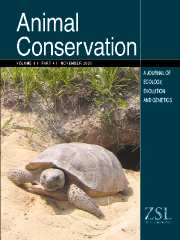Crossref Citations
This article has been cited by the following publications. This list is generated based on data provided by
Crossref.
South, A. B.
Rushton, S. P.
Macdonald, D. W.
and
Fuller, R.
2001.
Reintroduction of the European beaver (Castor fiber) to Norfolk, U.K.: a preliminary modelling analysis.
Journal of Zoology,
Vol. 254,
Issue. 4,
p.
473.
MacDonald, David W.
Moorhouse, Tom P.
Enck, Jody W.
and
Tattersall, Fran H.
2002.
Handbook of Ecological Restoration.
p.
389.
Macdonald, David W.
and
Rushton, Stephen
2003.
Modelling space use and dispersal of mammals in real landscapes: a tool for conservation.
Journal of Biogeography,
Vol. 30,
Issue. 4,
p.
607.
WILSON, CHARLES J.
2004.
Could we live with reintroduced large carnivores in the UK?.
Mammal Review,
Vol. 34,
Issue. 3,
p.
211.
Seddon, Philip J.
Armstrong, Doug P.
and
Maloney, Richard F.
2007.
Letters.
Conservation Biology,
Vol. 0,
Issue. 0,
p.
071107164019003.
Stephenson, C.M.
Matthiopoulos, J.
and
Harwood, J.
2007.
Influence of the physical environment and conspecific aggression on the spatial arrangement of breeding grey seals.
Ecological Informatics,
Vol. 2,
Issue. 4,
p.
308.
SEDDON, PHILIP J.
ARMSTRONG, DOUG P.
and
MALONEY, RICHARD F.
2007.
Developing the Science of Reintroduction Biology.
Conservation Biology,
Vol. 21,
Issue. 2,
p.
303.
Wisz, Mary S.
Tamstorf, Mikkel P.
Madsen, Jesper
and
Jespersen, Martin
2008.
Where might the western Svalbard tundra be vulnerable to pink‐footed goose (Anser brachyrhynchus) population expansion? Clues from species distribution models.
Diversity and Distributions,
Vol. 14,
Issue. 1,
p.
26.
O′Connell, MJ
Atkinson, SR
Gamez, K
Pickering, SP
and
Dutton, JS
2008.
Forage Preferences of the European Beaver Castor fiber: Implications for Re-introduction.
Conservation and Society,
Vol. 6,
Issue. 2,
p.
190.
Pinto, B.
Santos, M. J.
and
Rosell, F.
2009.
Habitat selection of the Eurasian beaver (Castor fiber) near its carrying capacity: an example from Norway.
Canadian Journal of Zoology,
Vol. 87,
Issue. 4,
p.
317.
Ruys, Thomas
Lorvelec, Olivier
Marre, Alain
and
Bernez, Ivan
2011.
River management and habitat characteristics of three sympatric aquatic rodents: common muskrat, coypu and European beaver.
European Journal of Wildlife Research,
Vol. 57,
Issue. 4,
p.
851.
Arts, Koen
Fischer, Anke
and
van der Wal, René
2012.
Common stories of reintroduction: A discourse analysis of documents supporting animal reintroductions to Scotland.
Land Use Policy,
Vol. 29,
Issue. 4,
p.
911.
Armstrong, Doug P.
and
Reynolds, Michelle H.
2012.
Reintroduction Biology.
p.
165.
WORTHINGTON, T.
KEMP, P. S.
OSBORNE, P. E.
DILLEN, A.
COECK, J.
BUNZEL‐DRÜKE, M.
NAURA, M.
GREGORY, J.
and
EASTON, K.
2012.
A spatial analytical approach for selecting reintroduction sites for burbot in English rivers.
Freshwater Biology,
Vol. 57,
Issue. 3,
p.
602.
Horn, Susanne
Prost, Stefan
Stiller, Mathias
Makowiecki, Daniel
Kuznetsova, Tatiana
Benecke, Norbert
Pucher, Erich
Hufthammer, Anne K.
Schouwenburg, Charles
Shapiro, Beth
and
Hofreiter, Michael
2014.
Ancient mitochondrial DNA and the genetic history of Eurasian beaver (Castor fiber) in Europe.
Molecular Ecology,
Vol. 23,
Issue. 7,
p.
1717.
Moore, P. G.
2014.
Natural history in newspapers: Dugald Semple (1884–1964), Ayrshire naturalist and nature journalist.
Archives of Natural History,
Vol. 41,
Issue. 2,
p.
1.
Law, A.
Bunnefeld, N.
and
Willby, N. J.
2014.
Beavers and lilies: selective herbivory and adaptive foraging behaviour.
Freshwater Biology,
Vol. 59,
Issue. 2,
p.
224.
Swinnen, Kristijn R. R.
Strubbe, Diederik
Matthysen, Erik
and
Leirs, Herwig
2017.
Reintroduced Eurasian beavers (Castor fiber): colonization and range expansion across human-dominated landscapes.
Biodiversity and Conservation,
Vol. 26,
Issue. 8,
p.
1863.
Hickerson, Brian T.
and
Walters, Annika W.
2019.
Evaluation of Potential Translocation Sites for an Imperiled Cyprinid, the Hornyhead Chub.
North American Journal of Fisheries Management,
Vol. 39,
Issue. 1,
p.
205.
Morris, Shane D.
Johnson, Christopher N.
and
Brook, Barry W.
2020.
Roughing it: terrain is crucial in identifying novel translocation sites for the vulnerable brush-tailed rock-wallaby (Petrogale pencillata).
Royal Society Open Science,
Vol. 7,
Issue. 12,
p.
201603.


